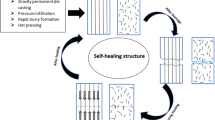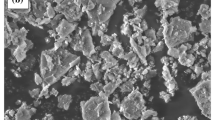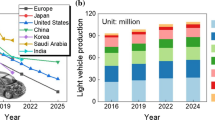Abstract
Stir casting is an economical process for the fabrication of aluminum matrix composites. There are many parameters in this process, which affect the final microstructure and mechanical properties of the composites. In this study, micron-sized SiC particles were used as reinforcement to fabricate Al-3 wt% SiC composites at two casting temperatures (680 and 850 °C) and stirring periods (2 and 6 min). Factors of reaction at matrix/ceramic interface, porosity, ceramic incorporation, and agglomeration of the particles were evaluated by scanning electron microscope (SEM) and high-resolution transition electron microscope (HRTEM) studies. From microstructural characterizations, it is concluded that the shorter stirring period is required for ceramic incorporation to achieve metal/ceramic bonding at the interface. The higher stirring temperature (850 °C) also leads to improved ceramic incorporation. In some cases, shrinkage porosity and intensive formation of Al4C3 at the metal/ceramic interface are also observed. Finally, the mechanical properties of the composites were evaluated, and their relation with the corresponding microstructure and processing parameters of the composites was discussed.











Similar content being viewed by others
References
Roshan M, Mousavian RT, Ebrahimkhani H, Mosleh A. Fabrication of Al-based composites reinforced with Al2O3–TiB2 ceramic composite particulates using vortex-casting method. J Min Metall Sect B. 2013;49(3):299.
Valibeygloo N, Khosroshahi RA, Mousavian RT. Microstructural and mechanical properties of Al-4.5 wt% Cu reinforced with alumina nanoparticles by stir casting method. Int J Miner Metall Mater. 2013;20(10):978.
Mohammadpour M, Khosroshahi RA, Mousavian RT, Brabazon D. Effect of interfacial-active elements addition on the incorporation of micron-sized SiC particles in molten pure aluminum. Ceram Int. 2014;40(6):8323.
Mohammadpour M, Khosroshahi RA, Mousavian RT, Brabazon D. A novel method for incorporation of micron-sized SiC particles into molten pure aluminum utilizing a Co coating. Metall Mater Trans B. 2015;46(1):12.
Naher S, Brabazon D, Looney L. Development and assessment of a new quick quench stir caster design for the production of metal matrix composites. J Mater Process Technol. 2005;166(3):430.
Naher S, Brabazon D, Looney L. Computational and experimental analysis of particulate distribution during Al–SiC MMC fabrication. Compos Part A Appl Sci Manuf. 2007;38(3):719.
Mousavian RT, Damadi SR, Khosroshahi RA, Brabazon D, Mohammadpour M. A comparison study of applying metallic coating on SiC particles for manufacturing of cast aluminum matrix composites. Int J Adv Manuf Technol. 2015;. doi:10.1007/s00170-015-7246-4.
Boostani AF, Tahamtan S, Jiang ZY, Wei D, Yazdani S, Khosroshahi RA, Mousavian RT, Xu J, Zhang X, Gong D. Enhanced tensile properties of aluminium matrix composites reinforced with graphene encapsulated SiC nanoparticles. Compos A. 2015;68(2):155.
Hashim J, Looney L, Hashmi M. Metal matrix composites: production by the stir casting method. J Mater Process Technol. 1999;92–93:1.
Naher S, Brabazon D, Looney L. Simulation of the stir casting process. J Mater Process Technol. 2003;143:567.
Hashim J, Looney L, Hashmi M. The enhancement of wettability of SiC particles in cast aluminum matrix composites. J Mater Process Technol. 2001;119(1):329.
Hashim J, Looney L, Hashmi M. The wettability of SiC particles by molten aluminum alloy. J Mater Process Technol. 2001;119(1):324.
Rajan T, Pillai R, Pai B, Satyanarayana K, Rohatgi P. Fabrication and characterisation of Al–7Si–0.35 Mg/fly ash metal matrix composites processed by different stir casting routes. Compos Sci Technol. 2007;67(15):3369.
Surappa M. Synthesis of fly ash particle reinforced A356 Al composites and their characterization. Mater Sci Eng A. 2008;480(1):117.
Ibrahim I, Mohamed F, Lavernia E. Particulate reinforced metal matrix composites–a review. J Mater Sci. 1991;26(5):1137.
Srivatsan T, Ibrahim I, Mohamed F, Lavernia E. Processing techniques for particulate-reinforced metal aluminum matrix composites. J Mater Sci. 1991;26(22):5965.
Rajan T, Pillai R, Pai B. Reinforcement coatings and interfaces in aluminum metal matrix composites. J Mater Sci. 1998;33(14):3491.
Schultz B, Ferguson J, Rohatgi P. Microstructure and hardness of Al2O3 nanoparticle reinforced Al–Mg composites fabricated by reactive wetting and stir mixing. Mater Sci Eng A. 2011;530:87.
Sukumaran K, Pillai S, Pillai R, Kelukutty V, Pai B, Satyanarayana K, Ravikumar KK. The effects of magnesium additions on the structure and properties of Al-7Si-10SiCp composites. J Mater Sci. 1995;30(6):1469.
Candan E, Atkinson HV, Turen Y, Salaoru I, Candan S. Wettability of aluminum–magnesium alloys on silicon carbide substrates. J Am Ceram Soc. 2011;94(3):867.
Prabu SB, Karunamoorthy L, Kathiresan S, Mohan B. Influence of stirring speed and stirring time on distribution of particles in cast metal matrix composite. J Mater Process Technol. 2006;171(2):268.
Urena A, Martınez E, Rodrigo P, Gil L. Oxidation treatments for SiC particles used as reinforcement in aluminum matrix composites. Compos Sci Technol. 2004;64(12):1843.
Tham L, Gupta M, Cheng L. Effect of limited matrix-reinforcement interfacial reaction on enhancing the mechanical properties of aluminum–silicon carbide composites. Acta Mater. 2001;49(16):3243.
Yan M, Fan Z. Review durability of materials in molten aluminum alloys. J Mater Sci. 2001;36(2):285.
Ureña A, Escalera M, Gil L. Oxidation barriers on SiC particles for use in aluminum matrix composites manufactured by casting route: mechanisms of interfacial protection. J Mater Sci. 2002;37(21):4633.
Monroe R. Porosity in castings. AFS Trans. 2005;113:519.
Lapham D, Schwandt C, Hills M, Kumar R, Fray D. The detection of hydrogen in molten aluminum. Ionics. 2002;8(5–6):391.
Yi J, Gao Y, Lee P, Flower H, Lindley T. Scatter in fatigue life due to effects of porosity in cast A356-T6 aluminum-silicon alloys. Metall Mater Trans A. 2003;34(9):1879.
Wang Q, Crepeau P, Davidson C, Griffiths J. Oxide films, pores and the fatigue lives of cast aluminum alloys. Metall Mater Trans B. 2006;37(6):887.
Hansen N. Hall-Petch relation and boundary strengthening. Scr Mater. 2004;51(8):801.
Viala J, Bosselet F, Laurent V, Lepetitcorps Y. Mechanism and kinetics of the chemical interaction between liquid aluminum and silicon-carbide single crystals. J Mater Sci. 1993;28(19):5301.
Pech-Canul MI. Aluminum alloys for Al/SiC Composites. In: Ahmad Z, editor. Recent Trends in Processing and Degradation of Aluminum Alloys. Shanghai: InTech; 2011. 299.
Lee JC, Byun JY, Park SB, Lee HI. Prediction of Si contents to suppress the formation of Al4C3 in the SiCp/Al composite. Acta Mater. 1998;46(5):1771.
Bao S, Tang K, Kvithyld A, Engh T, Tangstad M. Wetting of pure aluminum on graphite, SiC and Al2O3 in aluminum filtration. Trans Nonferrous Metals Soc China. 2012;22(8):1930.
Yang H, Gu M, Jiang W, Zhang G. Interface microstructure and reaction in Gr/Al metal matrix composites. J Mater Sci. 1996;31(7):1903.
Kobashi M, Choh T. The wettability and the reaction for SiC particle/Al alloy system. J Mater Sci. 1993;28(3):684.
Huber T, Degischer H-P, Lefranc G, Schmitt T. Thermal expansion studies on aluminum-matrix composites with different reinforcement architecture of SiC particles. Compos Sci Technol. 2006;66(13):2206.
Chawla N, Deng X, Schnell D. Thermal expansion anisotropy in extruded SiC particle reinforced 2080 aluminum alloy matrix composites. Mater Sci Eng A. 2006;426(1):314.
Mummery P, Derby B. The influence of microstructure on the fracture behaviour of particulate metal matrix composites. Mater Sci Eng A. 1991;135:221.
Cöcen Ü, Önel K. Ductility and strength of extruded SiCp/aluminum-alloy composites. Compos Sci Technol. 2002;62(2):275.
Arpon R, Molina J, Saravanan R, Garcia-Cordovilla C, Louis E, Narciso J. Thermal expansion behaviour of aluminum/SiC composites with bimodal particle distributions. Acta Mater. 2003;51(11):3145.
Lewandowski J, Liu C, Hunt W Jr. Effects of matrix microstructure and particle distribution on fracture of an aluminum metal matrix composite. Mater Sci Eng A. 1989;107:241.
Wang Z, Song M, Sun C, He Y. Effects of particle size and distribution on the mechanical properties of SiC reinforced Al–Cu alloy composites. Mater Sci Eng A. 2011;528(3):1131.
Author information
Authors and Affiliations
Corresponding author
Rights and permissions
About this article
Cite this article
Soltani, S., Azari Khosroshahi, R., Taherzadeh Mousavian, R. et al. Stir casting process for manufacture of Al–SiC composites. Rare Met. 36, 581–590 (2017). https://doi.org/10.1007/s12598-015-0565-7
Received:
Revised:
Accepted:
Published:
Issue Date:
DOI: https://doi.org/10.1007/s12598-015-0565-7




